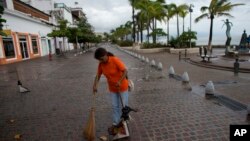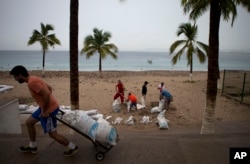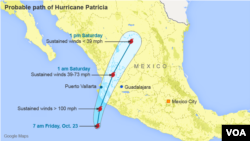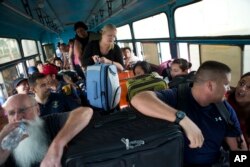The much-feared Hurricane Patricia over Mexico has weakened significantly after coming ashore as the strongest storm ever in the Western Hemisphere.
The storm has maximum sustained winds of 155 kilometers per hour, and diminishing, making it a Category 2 hurricane — drastically down from the 325 kilometers per hour just before making landfall Friday as a powerful Category 5 storm.
Mexican President Enrique Pena Nieto said "first reports confirm that the damage has been less than that corresponding to a hurricane of this magnitude." However, the president said "the phenomenon is continuing in its course" and urged people to remain in shelters. Considerable rainfall could produce life-threatening flash floods and mudslides.
So far, there have been no reports of fatalities or serious injuries.
Patricia continues to weaken as it moves farther inland over southwestern Mexico and across western and northern Mexico. Weather forecasters say the storm will turn into a tropical depression by Saturday afternoon.
Mexico's meteorological service said the hurricane struck Jalisco state, about 90 kilometers from the major cargo port of Manzanillo, at around 6:00 pm local time Friday with winds of 270 kilometers per hour.
Authorities relocated coastal residents, evacuated tourists and closed sea ports and airports as the Category 5 storm brought surging seas and heavy rain.
The U.S. National Hurricane Center said Patricia was expected to bring rainfall of 15 to 30 centimeters, and up to 50 cm in isolated areas.
Mexican authorities declared a state of emergency in dozens of municipalities in Colima, Nayarit and Jalisco states, a region that includes the cargo port of Manzanillo and the port resort of Puerto Vallarta.
Teams of police and civil protection officials warned people along the Puerto Vallarta waterfront to leave the area before Patricia hit the area. Tourists were seen leaving the city in a hurry.
Authorities began evacuating villagers, closing ports and schools, and urging tourists to cancel trips to the area.
The Mexican water commission warned that rivers could rise and roads could be flooded by the bad weather.
The Miami hurricane center warned that storm preparations should be rushed to completion, saying the hurricane could also cause coastal flooding, destructive waves and flash floods along the U.S. coast.
Patricia's power was compared to that of Typhoon Haiyan, which left more than 7,300 dead or missing in the Philippines when it swept ashore November 8, 2013.



